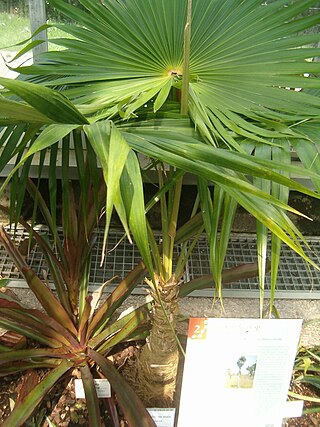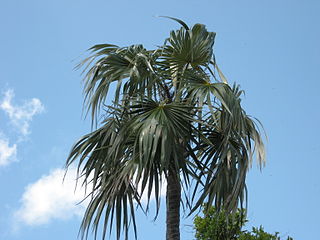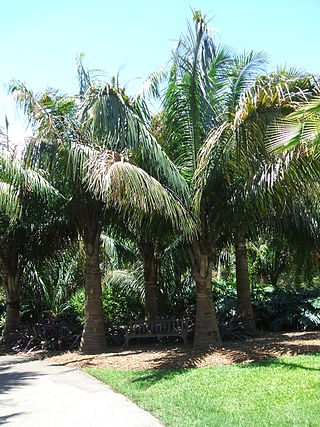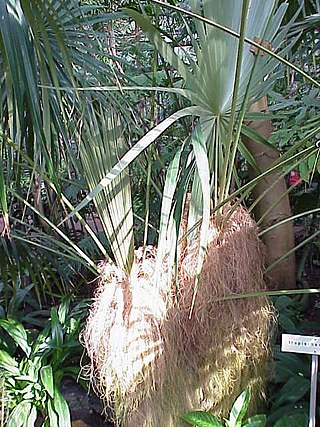
Coccothrinax is a genus of palms in the family Arecaceae. There are more than 50 species described in the genus, plus many synonyms and subspecies. A new species was described as recently as 2017. Many Coccothrinax produce thatch. In Spanish-speaking countries, guano is a common name applied to Coccothrinax palms. The species are native throughout the Caribbean, the Bahamas, extreme southern Florida and southeastern Mexico, but most of the species are known only from Cuba.

Coccothrinax barbadensis is a palm found in the Lesser Antilles. Like other members of the genus Coccothrinax, C. barbadensis is a fan palm. The leaves are widely used to thatch roofs.

Coccothrinax alta is a palm which is native to Puerto Rico and the Virgin Islands.

Coccothrinax argentata, commonly called the Florida silver palm, is a species of palm tree. It is native to south Florida, southeast Mexico, Colombia and to the West Indies, where it is found in the Bahamas, the southwest Caribbean and the Turks and Caicos Islands. Its natural habitat is rocky, calcareous soil in coastal scrubland and hammock communities.

Coccothrinax borhidiana is a palm which is endemic to Matanzas Province in Cuba. Like other members of the genus, C. borhidiana is a fan palm.

Coccothrinax readii, the Mexican silver palm, is a palm which is native to southeastern Mexico and northeastern Belize.

Zombia antillarum, commonly known as the zombie palm, is a species of palm tree and the only member of the genus Zombia. It is endemic to the island of Hispaniola in the Greater Antilles. Usually found in dry, hilly areas of northern and southern Haiti and the northwest of the Dominican Republic, Z. antillarum is a relatively short fan palm with clustered stems and a very distinctive appearance caused by its persistent spiny leaf sheaths. Threatened by habitat destruction in Haiti, Z. antillarum is a popular ornamental species due to its distinctive appearance, low maintenance requirements and salt tolerance.

Attalea crassispatha is a palm which is endemic to southwest Haiti. The most geographically isolated member of the genus, it is considered a critically endangered species and has been called one of the rarest palms in the Americas.

Coccothrinax crinita is a palm which is endemic to Cuba. Like other members of the genus Coccothrinax, C. barbadensis is a fan palm.
Coccothrinax concolor is a palm which is endemic to Haiti.

Coccothrinax fagildei or Fagilde's palm, is a palm which is endemic to Cuba.
Coccothrinax fragrans is a palm which is native to eastern Cuba and Hispaniola.
Coccothrinax inaguensis, the thatch palm or Inagua silver palm, is a palm which is endemic to the Bahamas and the Turks and Caicos Islands.
Coccothrinax jamaicensis, the silver thatch or Jamaican silver thatch, is a fan palm that is endemic to Jamaica.
Coccothrinax litoralis, the Cuban silver palm, is a palm which is endemic to Cuba.
Coccothrinax pauciramosa, the yuraguana or yuraguana vestida, is a palm which is endemic to Cuba. Like other members of the genus, C. pauciramosa is a fan palm. Trees are single-stemmed, between 2 and 5 metres tall with stems 4 to 8 centimetres in diameter. The fruit is purple-black, 0.7–1.2 cm in diameter.

Coccothrinax salvatoris is a palm which is endemic to eastern and east central Cuba. It grows up to 8 meters (26 ft) tall, and is found in open terrain less than 500 meters (1,600 ft) above sea level in areas with soils derived from limestone.

Thrinax radiata, also known as the Florida thatch palm, is a medium to slow growing palm in the family Arecaceae. It is native to many Caribbean islands, Mexico, Central America, and far southern Florida. Its natural habitat is sandy, calcareous soil in coastal areas.













